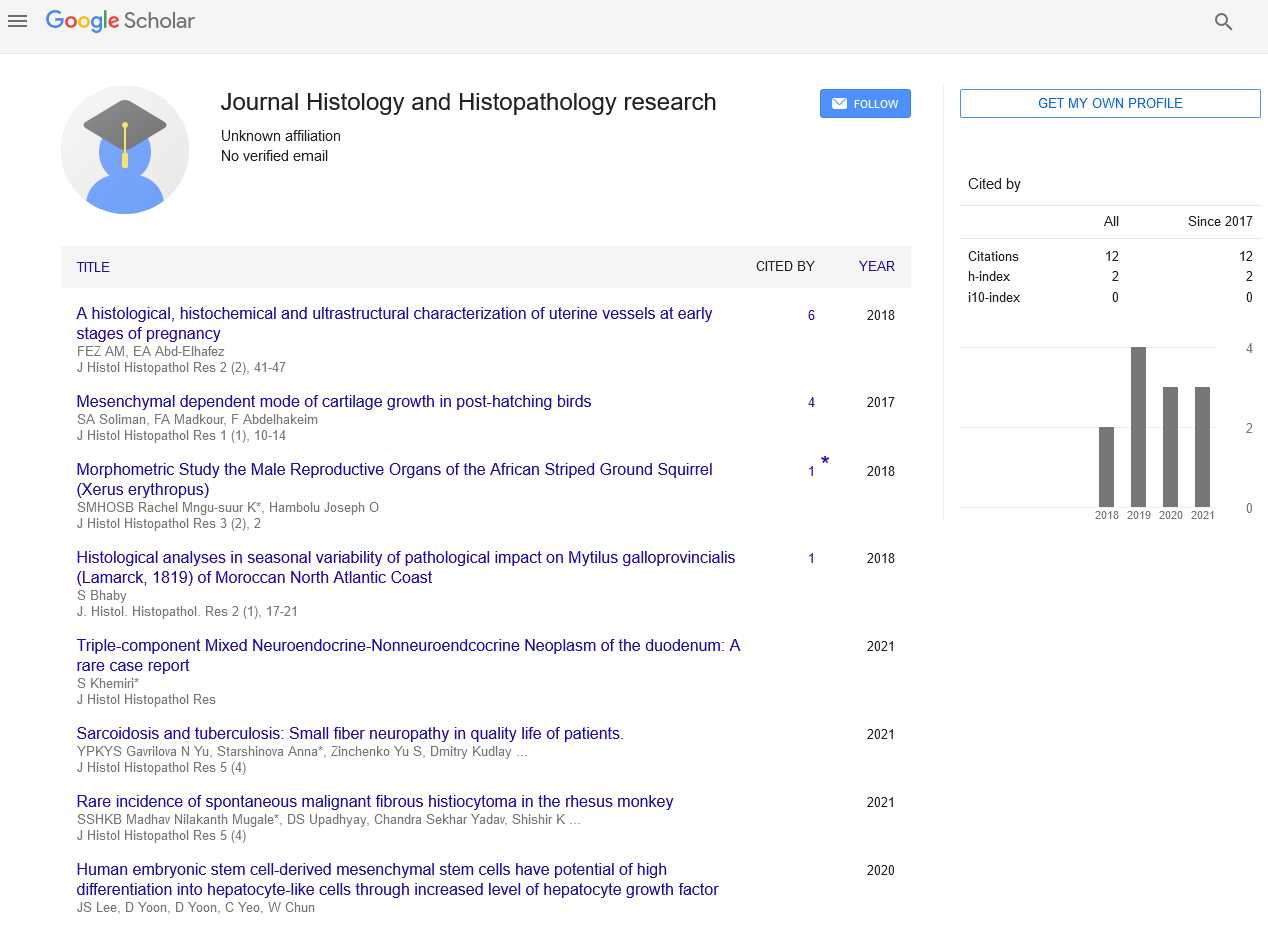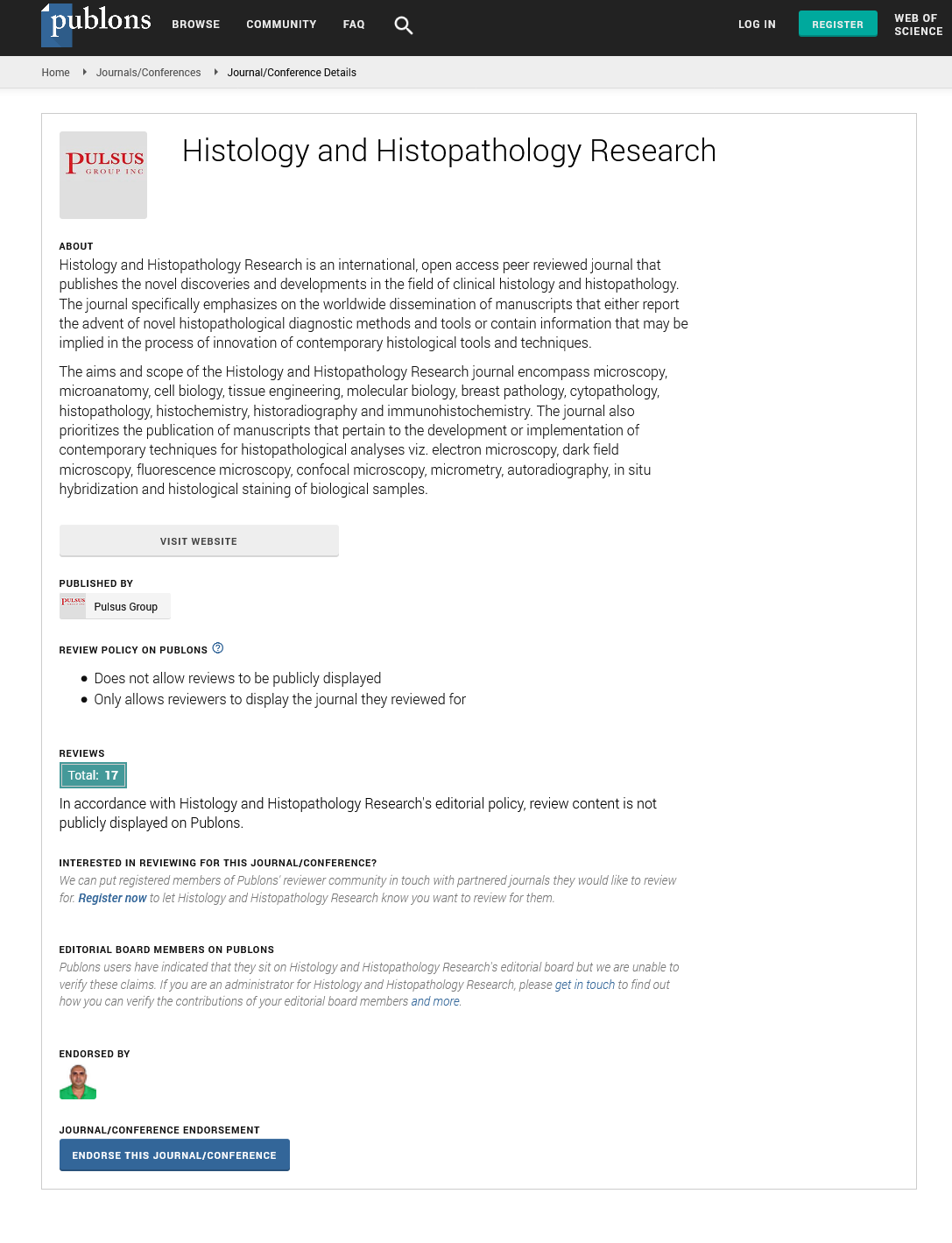Procedures for Histopathology: From Tissue Sampling to Histopathological Evaluation
Received: 05-Jul-2022, Manuscript No. pulhhr-22-5550 ; Editor assigned: 07-Jul-2022, Pre QC No. pulhhr-22-5550 (PQ); Accepted Date: Jul 23, 2022; Reviewed: 14-Jul-2022 QC No. pulhhr-22-5550 (Q); Revised: 18-Jul-2022, Manuscript No. pulhhr-22-5550 (R); Published: 28-Jul-2022, DOI: 10.37532. pulhhr.22.6 (4).89-90
Citation: Wells N. Procedures for Histopathology: From Tissue Sampling to Histopathological Evaluation. J Histol Histopathol Res. 2022;6(4):89-90.
This open-access article is distributed under the terms of the Creative Commons Attribution Non-Commercial License (CC BY-NC) (http://creativecommons.org/licenses/by-nc/4.0/), which permits reuse, distribution and reproduction of the article, provided that the original work is properly cited and the reuse is restricted to noncommercial purposes. For commercial reuse, contact reprints@pulsus.com
Introduction
The goal of histological processes is to produce high-quality tissue samples that can be examined under a light microscope. These can be used to spot changes brought on by diseases or those that occur naturally.
Typically, tissues are preserved with neutral formalin 10%, embedded in paraffin, and manually sectioned with a microtome to produce 4-5 m thick paraffin slices. Dewaxed sections can then be utilised for various procedures (specific stains, immunohistochemistry, in situ hybridization, etc.) or stained with HE&S (hematoxylin-eosin and saffron). To ensure consistent and understandable portions, several processes and procedures are essential throughout this processing. In order to effectively accomplish this goal, this chapter offers important guidelines.
Under a microscope, diseased tissue is examined in histopathology. Based on the study of human or animal histology, it is a crucial investigative medical technique (also called microscopic anatomy). Under a light microscope, a small tissue slice is examined to execute the procedure. Histotechnique is a collection of techniques that make it possible to see the microscopic characteristics of tissues and cells and identify certain microscopic structural alterations that occur in illnesses. The nineteenth century saw the description of the majority of histological procedures. They primarily employ physicochemical processes with tissue constituents to preserve, cut, or dye tissues. Tissue processing was not fully mechanised until the 1970s, and even then, crucial stages like embedding and sectioning were still done by hand.
These procedures need a lot of care, time, and resources.
The microscopic examination of sick tissue is called histopathology. It is a significant medical investigative technique that is based on the study of human or animal histology (also called microscopic anatomy). Under light microscopes, a small tissue slice is examined to accomplish the procedure. The histo method comprises of a range of techniques that enable imaging of microscopic characteristics of tissue and cells and the identification of certain microscopic structural alterations associated with illness.
Comparing diseased or deliberately changed tissues to corresponding samples from healthy or control counterparts is the primary concept behind histopathology examination. Therefore, strict standardisation of every histological procedure is crucial (i.e., specimen sampling, trimming, embedding, sectioning, and staining). This chapter's goal is to present several common histological processing techniques used for histopathological assessment, including paraffin embedding, sectioning, and staining. Other methods, such as unique stains, immunohistochemistry, in situ hybridization, etc., are also available and might be used on tissues for particular objectives.
Autolysis is a collection of postmortem alterations brought on by cell homeostasis breakdown, which results in uncontrolled water and electrolyte dynamics in and out of the cell as well as altered enzyme activity. These alterations eventually lead to the total obliteration of tissue structures and provide ideal circumstances for bacterial and fungal development. Tissues should be kept in a suitable fixative that permanently cross-links its proteins and stabilises it to prevent autolysis.
Autolysis almost starts right away once a person dies. After sample, quick and sufficient fixing is therefore crucial. The tissue sample can be submerged in a sufficient amount of fixative solution to achieve this. Aldehydes, mercurials, alcohols, oxidising agents, and derivatives of picric acid are a few of the fixing techniques. In biomedical research, glutaraldehyde or formaldehyde immersion of the tissue is the most used fixation technique. Commercially, formalin (formaldehyde) is sold as neutral phosphate-buffered solutions in concentrations of 38%–40% or 10%.
The gold standard for tissue examination for research or diagnostic purposes, for both qualitative and quantitative measures, is histological analysis. It is used to gauge the degree of inflammation or the healing process as well as to keep track of the amount of degradation products that have seeped into the tissue around them. Certain structures, organisms, tissues, and even metal components can be identified using various staining techniques. The most frequent staining is hematoxylin-eosin, which displays the cytoplasm and nucleus of cells in pink and blue, respectively. Other common staining methods used in the study of biodegradable metals include Masson's Trichrome to identify connective tissue, tartrate-resistant acid phosphatase for osteoclasts, Levai-Laczko for detecting bone mineralization, periodic blue acid shift, fluorochrome, and immunofluorescence stain, Quincke reaction, Turnbull blue, and Prussian to assess iron ions in the tissue. At the Dental School of Paris at the Descartes University, the skull samples were prepared for histological examination (1EA 2496, Montrouge, France). The skull samples were submerged in alcohol and then fixed in cold (4°C) 70% ethanol. The materials were dehydrated and then implanted in blocks of methyl methacrylate without demineralization. MMA blocks that had been carved were placed horizontally and perpendicular to the sagittal axis, then polish- -ed in a typical machine. Using the Jung Ultrafast and Jung Polycute microtomes, histological 5-mm-thick slices were made. Slices from the centre of the bone defects were taken in batches of 10 and put on glass sample holders that had been coated with albumin before being immersed in 80% ethanol to reduce thickness variation between samples. Toluidin Blue 1%, a metachromatic dye for quick contrast tissue examination and histological staining, was employed to calculate the percentages of bone neoformation. It was possible to see mineralized bone using the Von Kossa (VK) silver nitrate method. We employed the technique of intravenously tagging mineral matter with calceine/ demeclocycline in 5% physiologic serum 1 week and 1 day before sacrifice, respectively, to measure the quantification of the millimetres per day in the grown deformities. The enzymological test for evidence of Tartrate-Resistant Acid Phosphatase (TRAP) was used to assess the osteosynthetic activity of the newly created bone tissue, with red patches showing favourable findings. Alkaline Phosphatase (ALP) in osteoblasts and preosteoblasts was used as a tool to assess the osteosynthetic activity of the regenerated tissues. Cells that were violet-marked and indicated the length of the osteogenic strip in the samples were regarded as successful findings.






